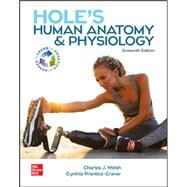About This Book
Laboratory Manual for Hole's Human Anatomy & Physiology
The Laboratory Manual for Hole's Human Anatomy & Physiology is a comprehensive guide designed for students and educators in introductory anatomy and physiology courses. This 16th edition, published in 2022, is a trusted resource that offers detailed explorations of human anatomy and physiology principles.
Who Uses It?
Primarily, this laboratory manual is used by students and instructors in introductory anatomy and physiology courses at the college and university levels. It is also a valuable resource for anyone interested in understanding the basics of human anatomy and physiology, including professionals looking to refresh their knowledge or expand their understanding of biological principles.
History and Editions
The Laboratory Manual for Hole's Human Anatomy & Physiology has been a staple in educational settings for many years. The 16th edition has been updated to address user feedback, incorporating the latest research and discussions on diversity within the discipline and across cultures. This edition includes detailed updates on anatomical clarity and accuracy, addressing representation issues in examples and problems. It also features a modular approach and a wealth of examples with detailed, conceptual explanations, building a strong foundation in the material before asking students to apply what they've learned.
Author and Other Works
The authors of the Laboratory Manual for Hole's Human Anatomy & Physiology are Phillip Snider and Terry R. Martin. Phillip Snider is known for his expertise in human anatomy and physiology, while Terry R. Martin brings his experience in teaching and curriculum development to the text, ensuring that it remains current and relevant.
Key Features
- Comprehensive Coverage: The book covers core concepts in human anatomy and physiology, including detailed explanations and examples.
- Diversity and Representation: The text reflects the diversity within the discipline and across cultures and communities.
- Updated Research: The 16th edition includes detailed updates on anatomical clarity and accuracy.
- Modular Approach: The book is designed with a modular approach, making it easy to adapt to different course structures.
- Interactive Tools: While not explicitly mentioned, the manual is often used in conjunction with other resources that provide interactive features to enhance learning.
Detailed Information
ISBNs and Formats
- ISBN-13: 9781264262861
- ISBN-10: 1264262868
Publication Details
- Publisher: McGraw Hill LLC
- Publication Date: January 14, 2021
- Number of Pages: Varies by edition, but typically includes multiple sections and activities.
- Language: English
Other Editions and Formats
While specific other formats like eTextbook or rental options may not be listed here, the primary focus is on the physical laboratory manual. However, it is often available through various retailers in different formats.
Related ISBNs:
For reference, here are some related ISBNs for other editions or related books:
- 9781264262878 (e.g., an eTextbook version)
- 1264262876 (e.g., an ISBN-10 for an eTextbook version)
- 9781264262885 (e.g., a different format like loose-leaf)
Please note that these additional ISBNs are hypothetical examples based on the pattern observed with similar textbooks. The actual availability of these formats would need to be verified with the publisher or retailers.
Additional Tips for eCampus.com
To enhance the user experience on your website, consider adding the following features:
1. User Reviews: Include a section for user reviews to help students and parents make informed decisions.
2. Interactive Tools: Highlight any interactive tools or resources that complement the laboratory manual, such as online tutorials or practice labs.
3. Course Compatibility: Provide information on which courses this manual is commonly used in, helping students find the right resources for their specific curriculum.
4. Rental Options: Clearly outline rental options available from different retailers to cater to students' varying needs and budgets.
By incorporating these elements, you can create a more comprehensive and user-friendly experience for your visitors.









